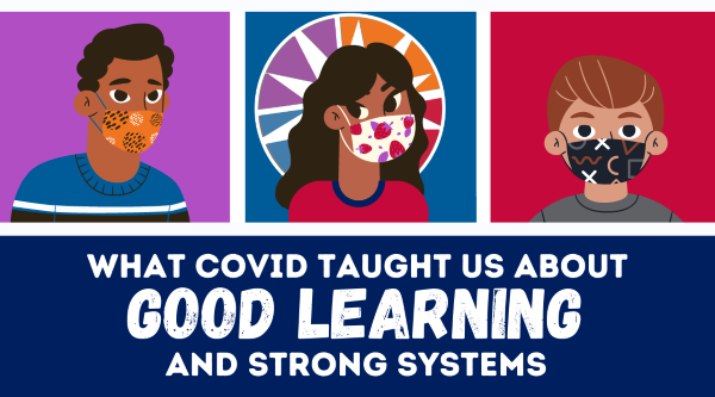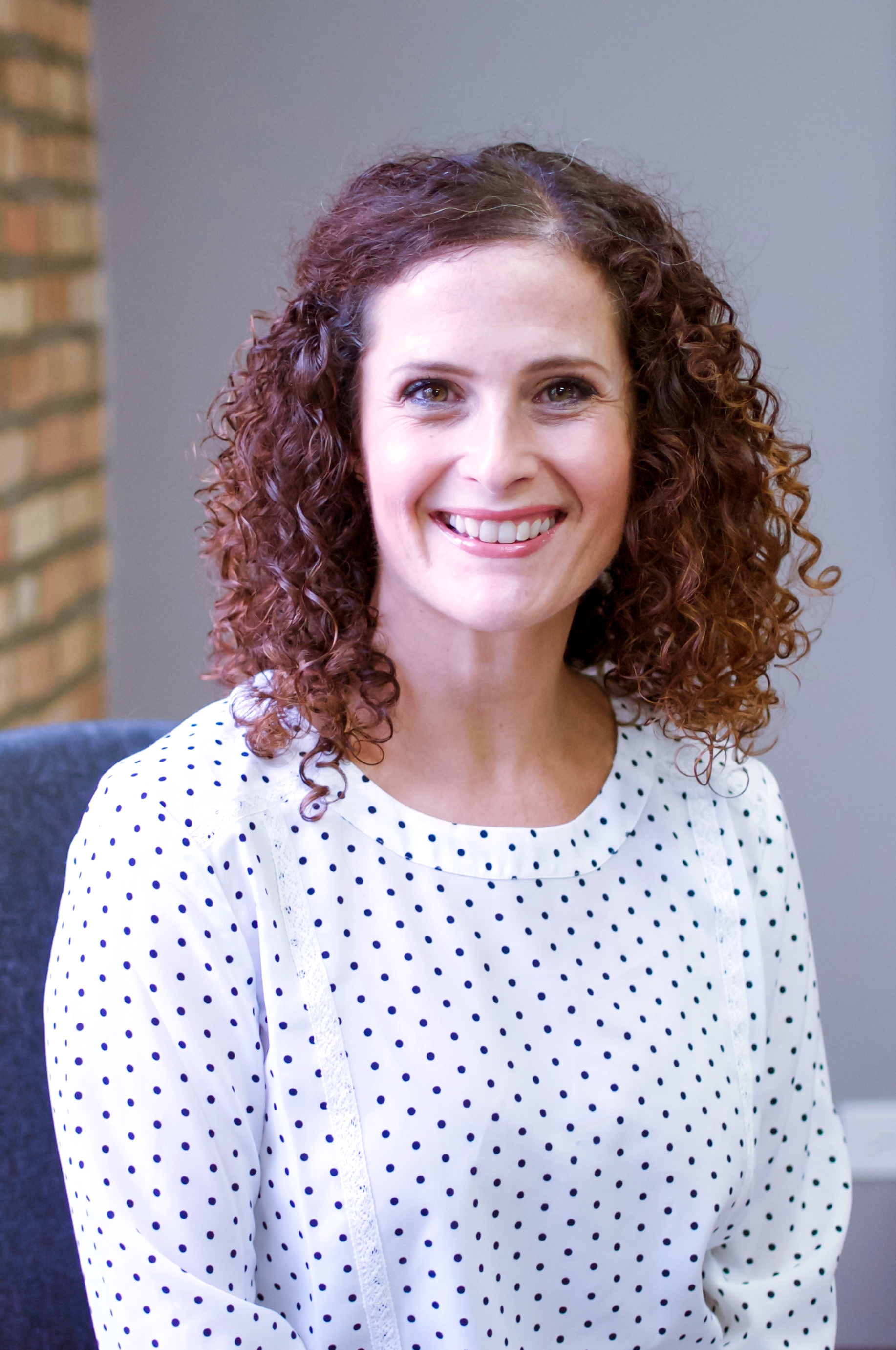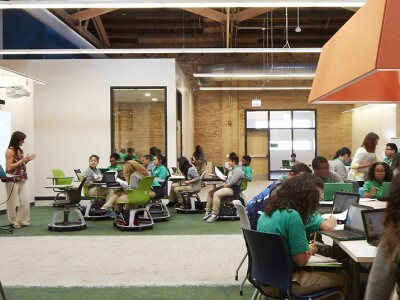What COVID Taught Us about Good Learning and Strong Systems
Topics

We’ve all had the experience of truly purposeful, authentic learning and know how valuable it is. Educators are taking the best of what we know about learning, student support, effective instruction, and interpersonal skill-building to completely reimagine schools so that students experience that kind of purposeful learning all day, every day.
The pandemic created unforeseen challenges, but it also created stronger home-school partnerships and positive changes in teacher practice.
As the nation continues to face the anxiety of a steady increase of COVID cases and more restrictive shutdowns, we are also beginning to allow ourselves to feel a bit of optimism about the potential of the vaccines on the horizon to change our current reality. At this winter break, educators feel similar conflicting emotions. We worry about not connecting with our students on a daily basis and having opportunities to check in with our families. At the same time, we wonder if the coming year will be the beginning of a return to normalcy and what elements of “normal” we will choose to return to. The past nine months have been a dramatic, but temporary, shift in our practice. We do not know what the future will bring, but we know it has to be better than what we’ve been through.
Our teachers at Distinctive Schools (DS) have been on this same roller coaster of emotions since March. At times, we feel like we are making small gains. We celebrate connecting with a student who hasn’t consistently joined virtual lessons, express gratitude for how we’ve been able to support one another, and have moments when we feel we are truly connecting with our students and families, even though we haven’t been able to connect in person. At the same time, we worry that we aren’t doing enough, lose sleep over the students that we don’t see or hear from, and long for the days when we can greet every child in person and welcome them to an actual classroom full of life and personality.
While the journey has been challenging and not one we hope to ever repeat, we realize we have learned a lot about ourselves, our students and families, and our beliefs. The past nine months have highlighted the ways in which we were unknowingly prepared for an abrupt shift to remote learning as well as gaps in our structures that need to be addressed, whether they be gaps related to our mindsets or ones related to our actual systems. The pandemic has forced us to rediscover and recommit to our true priorities.
A Strong Foundation
The shift to remote learning was sudden and unpredictable. Our normal routines and procedures were upended overnight and we had minimal guidance on how to move ahead. Teachers scrambled to ensure students had their devices and curricular materials, students struggled to comprehend that they would no longer see their teachers or friends in person but would still be “going to school,” and families had to figure out how they would support their children at home and still manage and fulfill their daily obligations as caregivers and working professionals. Despite these enormous challenges, we found ourselves uniquely positioned to navigate the uncertainties ahead. While DS had certainly never planned for teaching during a pandemic, we soon realized that we had structures in place that would allow us to bridge the physical distance while maintaining critically important relationships and emotional connections with each other and with our families.
These improvements may have been spurred by the pandemic, but they are not temporary.
Social-emotional learning (SEL) is a foundational element of the DS model. Our mission is “to support each child in becoming an engaged and curious learner, a confident self-advocate, and a creative problem-solver by setting high expectations and nurturing a positive culture that honors diversity, collaboration, and optimism.” This means that we attend to the needs of the whole child and that we emphasize emotional wellness and development as much as academic achievement. SEL took on even greater importance when the pandemic hit in March as we found ourselves suddenly separated from our students and families. We found that we could further leverage our use of DeansList to ensure ongoing communication with families and identify students who may be in need of more individualized support, whether it be attending to technology needs or addressing mental health concerns. Teachers did not have to learn a new platform to ensure this communication; instead, we took what we had to deepen our implementation and actually strengthen the school-family partnership.
Prior to the pandemic, DS had been exploring various SEL curriculums. The shift to remote learning accelerated the decision-making process and forced us to consider a new set of criteria that included whether or not material could be accessed anytime, anywhere and the ease of use for both families and students. In considering our options from a new perspective, we ultimately chose Move This World and are confident that this was the best choice for us, especially considering our current reality. The curriculum addresses modifications for remote learning, students don’t need extra materials to engage in the lessons, and our families have immediate access to a wide range of resources. In addition, Move This World hosts quarterly coaching calls when we can share both the successes and challenges of rolling out and implementing the curriculum and engage in productive and solution-oriented conversation.
While these structures have each contributed to our successful shift to remote learning, perhaps the key contributing factor has been our prioritization of relationships with families and deep understanding of our students. As an organization that values the whole child and one that utilizes a personalized learning model, we believe that positive relationships and academic achievement are intertwined. We conduct empathy interviews and facilitate family conferences to help strengthen and solidify the home-school connection, a connection that we had to really lean into and rely on as we shifted to remote learning. We use daily morning meetings and community gatherings at all grade levels to give our students a space to share their thoughts, feelings, and personal experiences in a trusting and safe space. While these structures existed prior to the pandemic, we have leaned into them even more deeply to ensure the physical separation doesn’t lead to emotional disconnection or less empathy. “Now that we’ve become integrated with family home life, there’s a depth to this relationship that we can’t lose sight of moving forward,” says Mike McCarthy, the executive director of student services. “Our teachers now have a unique insight into our students’ lives beyond the classroom. If we are truly committed to understanding who our students are and who they want to become, we must continue to deepen these connections.”
Continuing to Build
All of our schools have a 1:1 technology model; younger students have an iPad and middle school students have a Chromebook. In addition, much of our core and supplemental curricular resources can be accessed online, which also means that our students are able to navigate these platforms with a high degree of independence. Our IT department adopts a “cloud first” mentality, thus ensuring anytime, anywhere access for both students and teachers. While these approaches definitely supported us as we abruptly transitioned to remote learning, the pandemic has shone a light on work that is yet to be done and so we also continue to refine our structures.
Many of our schools have a high Spanish-speaking population. In order to meet our families’ needs and to ensure open and transparent communication, we are in the process of ensuring that our IT help center is available in Spanish, so that all of our community members can navigate the site with ease. In addition, we are adapting our response to tech requests based on individual needs. Prior to the pandemic, the help desk primarily served as a teacher resource. When the shift to remote learning required greater family involvement in supporting their child’s use of technology, we opened the help desk to our families in order to provide more immediate support. In doing so, we realized that we needed to tailor our responses to meet parents’ preferences and needs. For example, while the help desk is set up as an online support, some families prefer a phone conversation to speak to someone directly. In order to meet this need, our IT department is expanding their availability to include live phone support; this support will expand to include bilingual services this month. The team has also instituted “Tech Tuesdays” to provide additional training and heightened assistance for families and staff alike.
While access to technology has been a key structural support throughout the pandemic, it is important to remember that relationships remain the key ingredient. Richard McDonald, the network director of IT strategy, notes that Distinctive Schools’ strong culture has fortified the efforts of his team. “We’ve had a tremendous partnership with the instructional leaders. By working together, we’ve built a strong culture of support.”
Looking Back to Move Forward
As we continue to teach in a remote environment and simultaneously prepare for a still uncertain future, we are also taking the time to reflect on lessons learned. We see the true value of the parent-home connection and have an even deeper commitment to forging these relationships and engaging with our families as true partners. Many of our teachers note that they’ve never had so many conversations with parents before and that the conversations have a different tone. We are checking in with families to see how they are doing, to find out what they need, and to learn how we can support them. We are leveraging technology in new ways beyond academics. Technology connects us with one another, bridges the physical separation, and creates possibilities for stronger communication at every level of the organization. These improvements may have been spurred by the pandemic, but they are not temporary. They are shifts we commit to going forward.
Teachers and school leaders are also reflecting on our instructional priorities and the shifts we’ve made over the past months. Distinctive Schools’ Academic Team has invested significant time in analyzing the curriculum through the lens of remote learning and identifying which standards to prioritize in order to maintain grade-level expectations and academic rigor. The team has engaged in ongoing conversations with teachers and instructional coaches to better understand which elements of a curriculum that is designed for in-person learning lend themselves to a remote environment and which pose challenges. Collaboratively, we continue to tackle student engagement, both in terms of how to increase engagement when students are faced with so many challenges beyond the classroom and to identify what authentic engagement looks like in a Zoom lesson. The ongoing conversation and reflection also require that we revisit the purpose of our instructional decisions and re-engage with the “Why.” This is a piece of the conversation that had been missing in the past. We focused on knowing the pieces of the curriculum and the sequence of the lesson, but we rarely took the time to think about why the lesson is structured in a specific way or the intended outcome of each segment. In a remote environment, when maximizing every instructional minute is more important than ever, understanding the purpose is imperative. We have to move beyond navigating the logistics of the lesson and engage in deeper planning.
Understanding the curriculum must also be paired with understanding our students. A scripted curriculum alone will not ensure academic achievement. As with everything else, strong relationships provide the foundation for academic development and success. Planning must include conversations about our students and who they are, both academically and personally. Camille Hibbler, regional director of curriculum, instruction and assessment, perfectly sums up the work ahead, now and always: “We have to have actual conversations about how what we do has a direct impact on our kids.” While the pandemic has certainly created unforeseen challenges, it has also brought lasting change that we know will result in stronger home-school partnerships and teacher practice.
Image at top courtesy of Distinctive Schools.




